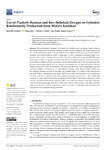Mostrar o rexistro simple do ítem
Use of Plackett–Burman and Box–Behnken designs to optimize bioelectricity production from winery residues
| dc.contributor.author | Devesa-Rey, Rosa | |
| dc.contributor.author | Arce Fariña, Elena | |
| dc.contributor.author | Cartelle, Alberto | |
| dc.contributor.author | Suárez-García, Andrés | |
| dc.date.accessioned | 2023-10-03T12:14:25Z | |
| dc.date.available | 2023-10-03T12:14:25Z | |
| dc.date.issued | 2023-08-25 | |
| dc.identifier.citation | Devesa-Rey, R.; Arce, E.; Cartelle, A.; Suárez-García, A. Use of Plackett–Burman and Box–Behnken Designs to Optimize Bioelectricity Production fromWinery Residues. Water 2023, 15, 3051. https://doi.org/10.3390/w15173051 | es_ES |
| dc.identifier.issn | 2073-4441 | |
| dc.identifier.uri | http://hdl.handle.net/2183/33525 | |
| dc.description.abstract | [Abstract]: This study aimed to estimate the bioelectricity production process using a vinasse solution through the application of Plackett–Burman and Box–Behnken designs. An electrochemical cell was constructed using Arduino to measure the potential difference between an anode and cathode immersed in a vinasse solution, which is a byproduct of wine production containing organic compounds and ions that undergo redox reactions. The Plackett–Burman design identified the most influential variables among eight previously selected (concentration of the electrolyte, pH, temperature, stirring, addition of NaCl, yeast dose and electrode:solution ratio). The results showed that the most influencing variables were the vinasse concentration and stirring and a peak of 306 mV could be observed for a 100 mL experiment. The third most influential variable regarding the process was NaCl addition, which showed its high influence at larger times. Based on these results, the Box–Behnken design was used to determine the possible ranges of variation of the independent variables (vinasse concentration, stirring and NaCl dose) to maximize the bioelectricity production. Therefore, with the combination of the intermediate concentrated vinasse (1:3 v/v ratio) and stirring, a peak of 431.1 mV could be observed when adding 2% NaCl after 15 min of the experiment. In what concerns the instant bioelectricity, measured after 1 min of the experiment, values up to 437.9 mV could be observed although yeast and/or NaCl are necessary at short times. This study provides insights into the bioelectricity production process from vinasse, contributing to the understanding and potential for sustainable energy generation. | es_ES |
| dc.description.sponsorship | Centro Universitario de la Defensa en la Escuela Naval Militar ; PICUD-2022-02 | es_ES |
| dc.language.iso | eng | es_ES |
| dc.publisher | MDPI | es_ES |
| dc.relation.uri | https://doi.org/10.3390/w15173051 | es_ES |
| dc.rights | Attribution 4.0 International (CC BY 4.0) | es_ES |
| dc.rights.uri | http://creativecommons.org/licenses/by/3.0/es/ | * |
| dc.subject | Wine | es_ES |
| dc.subject | Electrolysis | es_ES |
| dc.subject | Microbial cell | es_ES |
| dc.subject | Design of experiments | es_ES |
| dc.title | Use of Plackett–Burman and Box–Behnken designs to optimize bioelectricity production from winery residues | es_ES |
| dc.type | info:eu-repo/semantics/article | es_ES |
| dc.rights.access | info:eu-repo/semantics/openAccess | es_ES |
| UDC.journalTitle | Water | es_ES |
| UDC.volume | 15 | es_ES |
| UDC.issue | 17 | es_ES |
Ficheiros no ítem
Este ítem aparece na(s) seguinte(s) colección(s)
-
GI-CTC - Artigos [83]






